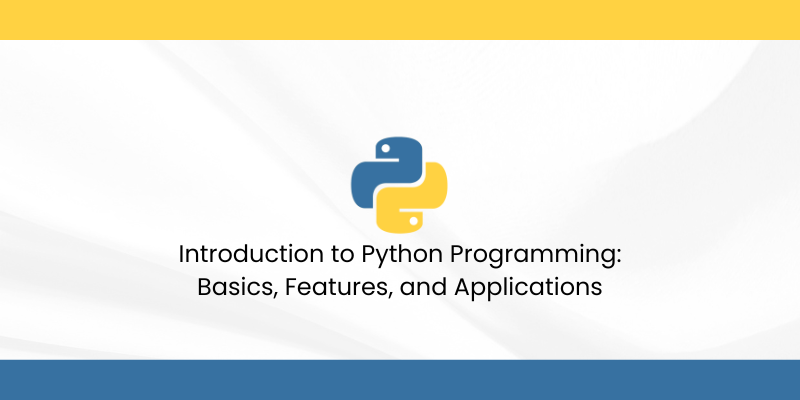
Python is one of the world's best-known programming languages, widely recognized for its user-friendliness, versatility and wide application scope. From beginners learning the ropes to experienced programmers working on complex projects requiring Python libraries - Python offers user-friendly syntax as well as extensive sets. This article presents a thorough introduction to Python programming covering its basics as well as important features and practical applications.
Python is an open-source high-level programming language designed to increase efficiency and readability. Created by Guido van Rossum during the latter part of the 1980s, Python quickly became essential in areas like web development as well as artificial intelligence, data science, automation, etc. It is based on an interpretation as well as a rapidly typed method, which makes it ideal for fast development of applications.
If you're brand new to programming Python's easy to learn syntax is a great beginning point. Here are some basic concepts:
Python's syntax is easy and succinct it is focused on the readability. Different from other languages that rely on brackets {in the form of to denote elements of programming, Python makes use of the indentation to define the structure of programming.
A simple example of Python program:
print("Hello, World!")
Output:
Hello, World!
Python supports a variety of types of data which include:
- Integers ( int) (int): Total figures (e.g., 10 5, 1000,)
- Numbers with floating points ( float) Decimal figures (e.g., 3.14, 2.71)
- Strings (str): Text data (e.g., "Python")
- Lists Collections that are ordered (e.g., [1 2 3, "apple"])
- Tuples Collections that are immutable and ordered (e.g., (10 20 "banana"))
- Dictionaries: Key-value pairs (e.g., )
Example:
Name is "Alice" age = 25 is_student = true print(f" is years old.")
Python allows conditional statement as well as loops to control program behavior.
If-Else Statements
age = 18 if you are over 18, print("You can cast a vote.") alternatively: print("You cannot cast a ballot.")
Loops (for and while)
for i in range(5): print(i)
Functions enable code reuse as well as modular programming.
Example:
def greet(name) def greet(name): return f"Hello", name!" print(greet("Alice"))
Python is popular because of its unique characteristics:
Python code is similar to English which makes it much simpler to understand and troubleshoot.
Python doesn't require compilation. Code is executed line-by-line.
Variables are not required to be explicitly declared. declaration of the data types.
Python offers a wide array of libraries, including:
- NumPy Pandas (for the analysis of data)
- TensorFlow PyTorch (for Machine Learning)
- Django, Flask (for web development)
Python can be utilized on many different platforms, including Windows, Linux and macOS.
Python supports object-oriented principles such as inheritance, encapsulation and polymorphism.
Python has long been utilized across industries due to its adaptability.
Python is widely employed to build interactive web apps. The most popular web frameworks are:
- Django Framework with high level that allows for robust web-based applications
- Flask A lightweight framework that can be used for small-scale projects
A basic example of Flask application:
From flask import Flask app from flask import Flask app Flask(__name__) @app.route ('/') home() Return "Hello, World!" if __name__ == '__main__': app.run(debug=True)
Python is the preferred language used for analyses of data as well as AI creation. The most popular tools are:
- Pandas, NumPy - For data processing
- Matplotlib, Seaborn - For data visualization
- TensorFlow Scikit-learn for machine learning.
Example using Pandas:
import pandas as pd data = df = pd.DataFrame(data) print(df)
Python is used to automate repetitive tasks like:
- Scraping websites (using BeautifulSoup)
- Handling of files (using os and shutil modules)
- Automating reports and emails
An example of how to automate the handling of files
import os files = os.listdir("C:/Users/Documents") for file in files: print(file)
Python is a tool used for game creation with Pygame, one of the premier gaming development programs available today.
Python has long been considered an indispensable choice for security tools and penetration tests that combine vulnerability testing with malware analyses.
Python is an extremely robust yet easy-to-learn python programming course with multiple uses across industries and domains. Due to its adaptability, flexibility, and extensive library it makes an excellent choice for developers working across web development, analytics, AI and automation applications. If you are new to programming or simply keen to improve your knowledge then Python remains one of the best languages to master and study.
Utilizing Python's powerful features and extensive ecosystem, you can craft inventive solutions and streamline tedious tasks efficiently. Begin coding with Python today to explore the infinite possibilities!